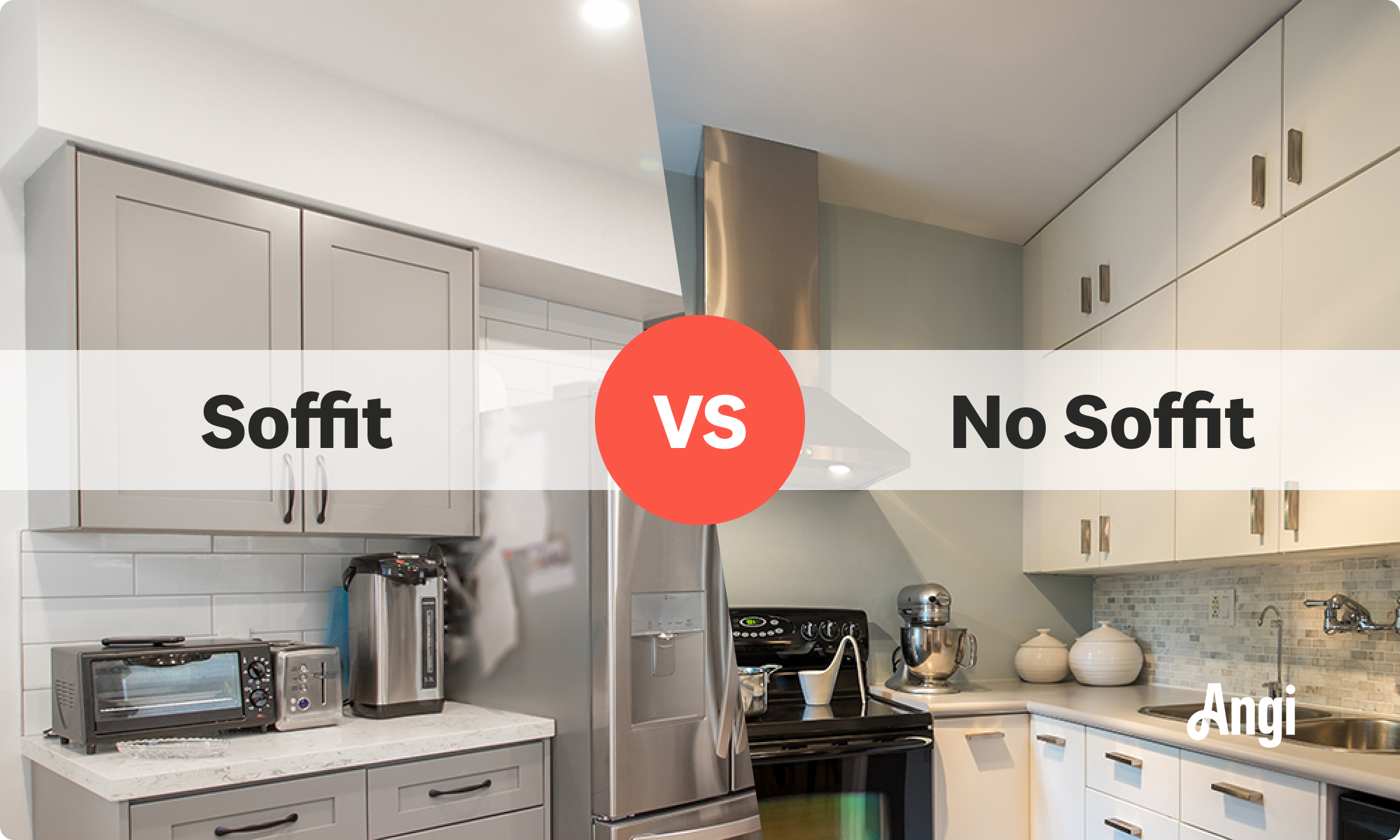What Is a Soffit in a Kitchen?
That empty space above your kitchen cabinets can be filled with a soffit


Highlights
Soffits can be used to hide wiring, HVAC, or plumbing.
Soffits can make a space more streamlined and easier to clean.
Removing soffits can make ceilings look taller.
Soffits cost $8 per linear foot on average.
Removing soffits costs $8.20 per linear foot on average.
If you’re considering a renovation or plan to change up your cabinets, you might be considering the space above your upper kitchen cabinets. To fill the space, you can build a soffit, and if you already have a soffit, you might be considering removing it. Here’s what a soffit is in your kitchen so you can confidently go forth.
What Is a Soffit in a Kitchen and What Is it For?

A soffit is usually used to fill the space between the upper cabinets and the ceiling in a kitchen. The soffit is made by building a short wall that extends down from the ceiling like a step and then filling in the open bottom edge to form a slightly lower ceiling panel. A soffit can extend into the room beyond the edges of the cabinets to accommodate light fixtures, vents, or range hoods.
Soffits can be used where ducting needs to travel below the ceiling. A soffit might be built to hide ducting for HVAC traveling through the room. It can also be used to accommodate wiring for range hoods, lighting, or other kitchen appliances. In some cases, soffits can also disguise water pipes that don’t fit behind the walls.
Soffits can also be added for cosmetic reasons to fill unused space or add inset lighting. Some people prefer not to have open, unused space above cabinets, so adding a soffit makes things look cleaner. These types of soffits are entirely a matter of preference, so they can be removed easily to free up the space if you want to use it differently.
Types of Kitchen Soffits
Kitchen soffits can come in various shapes and sizes, and the materials they’re made from will affect how they look in your kitchen. Other factors affecting the type of soffit you might choose are the function of your soffit and the kind of light fixtures and HVAC you have in your kitchen.
Soffit Materials
Soffits can be made from either drywall or wood. You may use molding or trim to finish the soffit's edge and match your cabinets. On the other hand, you can also choose to leave your soffits smooth to avoid adding extra area to dust.
Fitted Soffits
Soffits that are fitted to the exact size of your cabinets are usually there to fill in the space between the top of the cabinets and the ceiling. These soffits have a mostly cosmetic function, but they can also make cleaning easier by reducing the surface area above your cabinets.
Large Soffits
If you have soffits extending past the edges of your cabinets, these are often used to mask wiring, plumbing, or HVAC, but they can also accommodate recessed lighting fixtures. This type of soffit will lower the ceiling height for a section of the room, but it also might make installing lighting easier. Soffits made for a custom appliance or range hood might also extend past the edges of your cabinets for cosmetic reasons.
Why You Might Want Kitchen Soffits
Soffits are often used to hide wiring, HVAC, and plumbing. A soffit can be built around pipes that travel inside the walls, to hide wiring for light fixtures and appliances, or to cover dust work and accommodate vents for heating, cooling, and air circulation. In areas with architectural or engineering obstacles to keeping wiring, ducting, and plumbing behind the walls, a soffit can be built to keep them out of sight. A soffit covers these elements and makes it easier to keep the area clean by eliminating exposed surfaces.
Uses of Kitchen Soffits
Hide wiring
Hide duct work
Hide pipe and plumbing
Accommodate vents
Accommodate inset lighting fixtures
Accommodate range hoods
Accommodate appliances
Make cleaning easier
Why You Might Not Want Kitchen Soffits

If you have kitchen soffits that aren’t being used to mask unsightly utility lines or HVAC, there are plenty of reasons that you might want to get rid of them. The extra space above your cabinets doesn’t have to be unused. You can extend your cabinets upwards, use the extra space for decor, or add other storage above the cabinets. Having open space above the cabinets can also make your ceilings look higher, even if you don’t plan to use it for a practical purpose. Removing soffits in kitchens with open shelving can make the space more functional and help the space appear less cluttered.
Reasons to Remove Soffits
Allow more open space
Open up storage space
Make room to extend cabinets to the ceiling
Make your ceilings look taller
Make your open shelving look less cluttered
Make the space in your kitchen more functional
Cost of Adding Kitchen Soffits
Adding a soffit in the kitchen costs $8 per linear foot on average, but it can range from $4 to $12 per linear foot, depending on the job's difficulty. Most kitchens will have between 100 and 200 linear feet of soffit, so adding a soffit to most kitchens will cost between $400 and $2,400, depending on the soffit size and how difficult it is to install.
Cost of Removing Soffits
On average, it costs $8.20 per linear foot to remove kitchen soffits but can range from $4.98 to $11.42, depending on the job's complexity. Most kitchens will have between 100 and 200 linear feet of soffit, so removing a soffit from the average kitchen will cost between $498 to $2,284, depending on the size of the kitchen and the difficulty of removing the soffit. The cost of eliminating soffits doesn’t include rerouting any pipes, HVAC, or electrical equipment that’s behind them, so keep that in mind when calculating costs.
